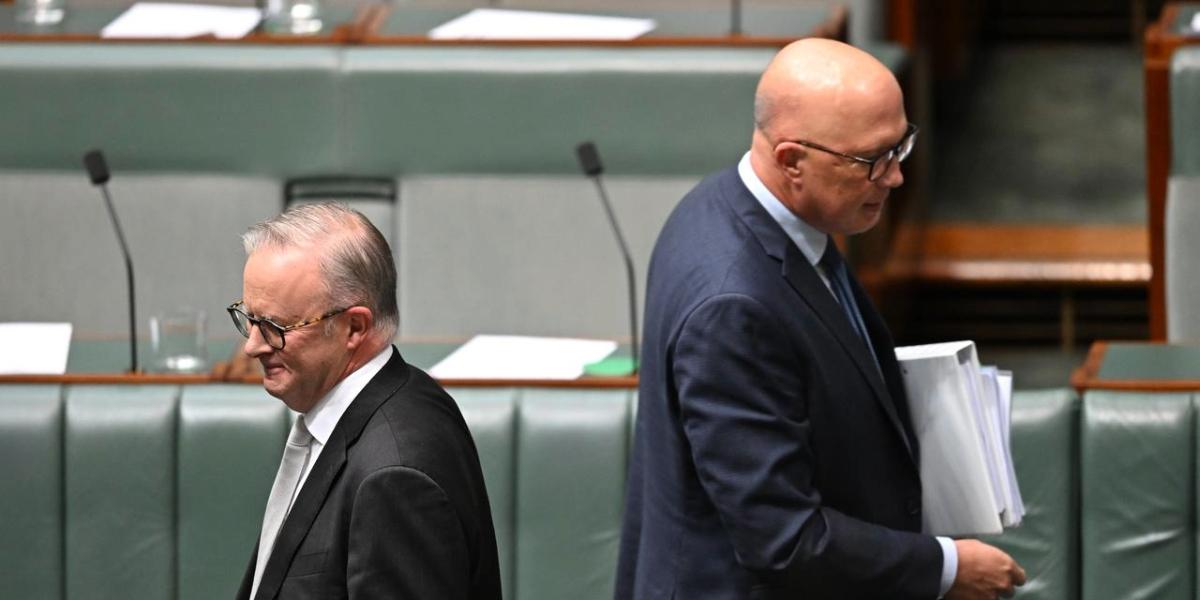Peter Dutton appears to be kicking with the wind behind his back, with multiple opinion polls showing the Albanese government could be on the nose with voters as an election nears.
The latest Newspoll published in The Australian newspaper on Monday shows the coalition has a 51-49 lead over Labor in the two-party preferred stakes.
Labor’s primary vote is languishing at 31, compared to the coalition’s 38, the poll found.
Some 53 per cent of those surveyed believed the Albanese government did not deserve to be re-elected, while 34 per cent were happy to give it another term.
About 45 per cent believed Prime Minister Anthony Albanese would be the better PM, compared to Mr Dutton’s 40 per cent.
The poll surveyed 1244 voters nationally last week.
Federal MPs linked the result to cost of living pressures faced by voters, with independent Jacqui Lambie telling Nine’s Today show “it’s very scary out there”.
But senior Labor minister Tanya Plibersek said the opposition had no plan to help families.
“That is why it is so important that we remind people that Peter Dutton has opposed every single cost of living measure that we have tried to introduce,” she told Seven’s Sunrise program on Monday.
“He’s got no plan to take pressure off families.”
Nationals MP Barnaby Joyce said Ms Plibersek was “rubbing salt into the wound of people” doing tough.
“It is a debacle and part of our plan (to address the cost of living) is to remove you,” he told Seven.
Meanwhile, the latest modelling by YouGov released on Sunday projects the coalition to win 73 seats in the 150-member House of Representatives, well ahead of Labor on 66.
The result, if replicated at the federal election which must take place by May 17, would leave the opposition leader in the box seat to negotiate with the cross bench and become Australia’s next prime minister, YouGov director of public data Paul Smith said.
It would also make Labor the first single-term federal government since 1931.
Mr Dutton said the teal independents’ voting pattern showed they were unlikely to back him over Prime Minister Anthony Albanese, cautioning Australians that a vote for the teals was a vote for a Labor-Greens-independent government.
“They should be transparent with the public, so that if you go and vote for Kate Chaney or Zali Steggall or Monique Ryan or Allegra Spender, you should know that in a hung parliament, they are going to support Labor or Liberal,” he told reporters in Darwin.
“Otherwise, why would you vote for them? Because at the moment, a vote for a green teal is a vote for Anthony Albanese, and the green teals will only support Anthony Albanese.”
But Ms Spender, the independent MP for Wentworth, seemed open to supporting the coalition.
Her priority would be ensuring the stability of the government, so whichever party had more seats would form part of her consideration, she said.
“It is one of the factors. But I think we also need to look at what the shape of the cross bench looks like, and what the shape of that support is,” she told the ABC’s Insiders program.
As well as the teals’ traditional concern with climate change, policies determining her decision would also include housing, tax and productivity reform, Ms Spender said.
Haemorrhaging votes in working class outer suburbs, Labor was on track to lose 15 seats but gain three from the Greens in Brisbane
“There is no doubt that this election will be decided by working class voters in outer Sydney and Melbourne and other parts of Australia who have been doing it tough with the cost of living,” Mr Smith said.
Mr Dutton doubled down on his cost-of-living focus, threatening to split up insurance companies if they gouged consumers, similar to his plan to give the consumer watchdog divestiture powers to break up supermarket giants Coles and Woolworths.
“The best way to get the cost-of-living crisis resolved that Labor has created, the best way to get the housing crisis that Labor has created resolved, and the best way to get the energy crisis resolved that Labor has created is to support a coalition government,” he said.
YouGov’s multi-level MRP modelling takes voter intentions and converts it into a prediction for each electorate, with the coalition taking a 3.2 per cent swing off Labor on a two-party preferred basis.
Labor’s primary vote share was projected to slip below 30 per cent while the coalition’s would lift to 37.4 per cent.
But that was only the model’s central result out of a range of possible outcomes. And polling is often inaccurate at this point in the electoral calendar.
The coalition still had a chance at forming majority in their own right, on course to land anywhere between 65 and 80 seats, while Labor was set to win 59 to 72 seats, the Greens one to three, and independents seven to 10.
The election must be held no later than May 17, with strong predictions it will be called for April 12.
Follow all the New England Times coverage of the federal election here or have your say on Engage
See more about the race in New England here
See more about the race in Parkes here


